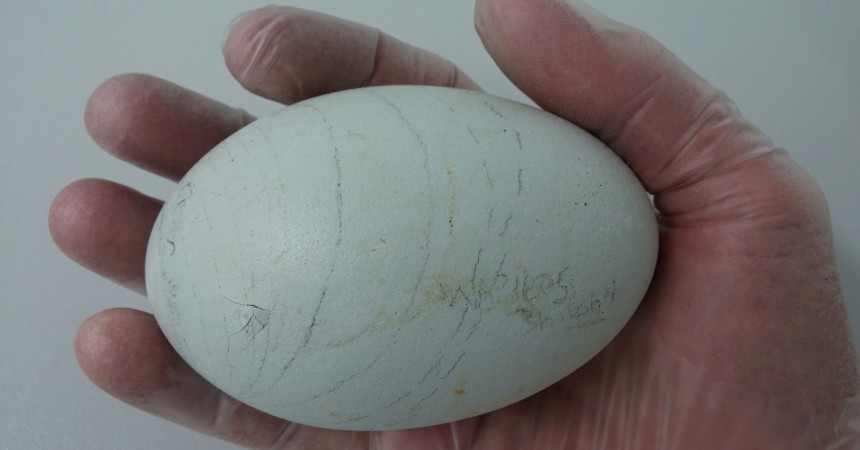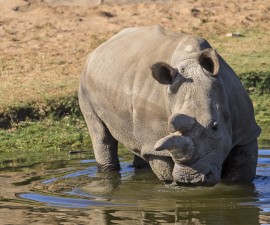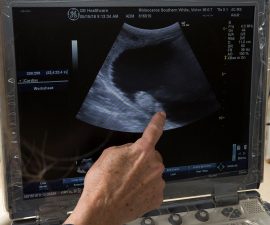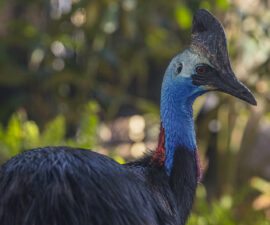The big hatch day is quickly approaching, and our devoted California condor parents, Sisquoc and Shatash, have been patiently caring for and incubating their egg. Well, actually, they’ve been caring for a wooden egg that we refer to as a “dummy” egg. We use a dummy egg as a type of placeholder until their real egg is ready to hatch. It’s not that we don’t trust them with a real egg; on the contrary, they have proven to be very reliable parents! But when we artificially incubate an egg while the parents sit on a dummy one, we can more closely and conveniently monitor the egg’s progress, and offer any necessary assistance without disturbing the doting parents. When the real egg is about to hatch, we carefully switch out the dummy egg while the parents are in the flight pen eating or sunning. They usually don’t even realize we switched eggs on them. They just return to their incubation duties—but now their egg is moving and squawking underneath them as they sit.
California condor eggs start the hatching process after 53 to 56 days of incubation. The process can first be seen when the air cell begins to quickly expand. The air cell is a pocket of air at the big end of the egg. Next time you crack open a chicken egg at home, look for the air cell. Once the air cell expands against the embryo’s beak, the membrane of the air cell is pierced, initiating pulmonary respiration—the first time the condor chick breathes air. The chick is now breathing in more oxygen than can enter through the pores of the eggshell, and as a result, carbon dioxide builds up in the egg. This buildup stimulates the chick to start pushing until the shell is finally broken, with a dime-sized bump raised in the shell. This is called a “pip.”
Once the chick pips the shell, more oxygen can enter the egg, and the chick continues the hatching process. Blood vessels lining the interior of the egg are shut off; the yolk sac is retracted into the chick via its umbilicus. We obviously cannot see these processes, but we can see the chick breathing, pushing or poking at the pip site, nibbling on shell membranes, and enlarging the pip site by breaking more shell. Every once in a while, we can even hear the chick squawk from inside!
When the yolk sac is fully retracted and the blood vessels are ready, the chick begins to rotate inside the egg. As the chick pushes against the interior of the shell, it breaks the shell. As you can imagine, this is a very tiring activity for the little chick! The parents don’t break any new sites on the shell for the chick, but they do remove pieces of shell. When the chick is almost fully rotated, it starts to push harder inside the egg, resulting in the shell expanding until the top comes off. This is called “capping.” The parents then help the chick more, removing the capped shell or even pulling the bottom of the eggshell off the chick. At this point, we consider the chick hatched!
The pip-to-hatch period can vary for each species of bird, but for California condors it can last between 48 and 72 hours. We have seen some parent-hatched chicks take a little longer (about 85 hours) to hatch with no ill effects.
Sisquoc and Shatash’s egg pipped very early in the morning on March 28, on day 53 of incubation—a couple of days earlier than we anticipated! While they were both eating in their flight pen, we quietly snuck into the nest and replaced the dummy egg with their pipped egg. If all continues to go well, it should hatch around the morning of March 31, but it could be slightly earlier or later. Check into Condor Cam frequently to try and watch for the hatching chick. This is a rare opportunity to see the inside of a condor nest. We hope you enjoy this exciting event as much as we do! Happy viewing!
UPDATE April 2, 2016: Yesterday, animal care staff observed that the condor chick that was being monitored via condor cam was having difficulty during hatching. They immediately removed the chick for veterinary care where it was assisted with its hatch and given medical support. Today it appears to be active and alert. Animal care and veterinary staff will continue to monitor it for the next few days.
Ron Webb is a senior keeper at the San Diego Zoo Safari Park. Read his previous blog, Get Ready to Condor Cam!





